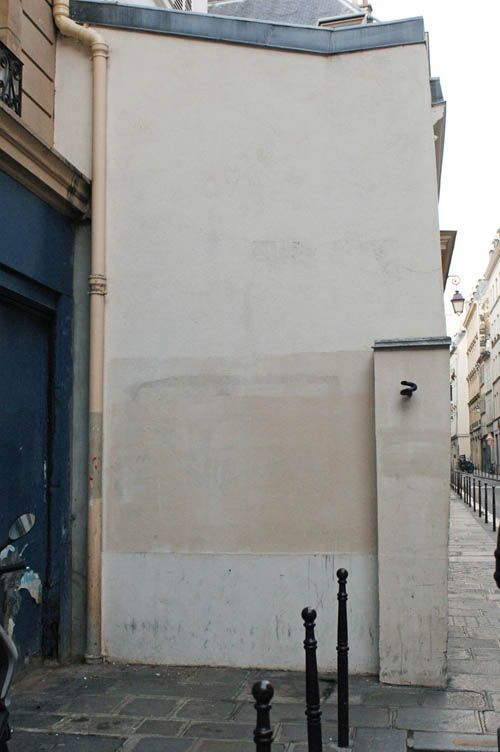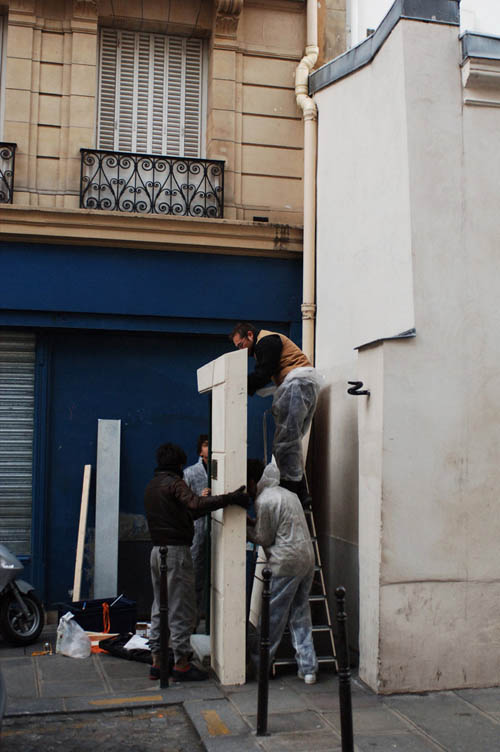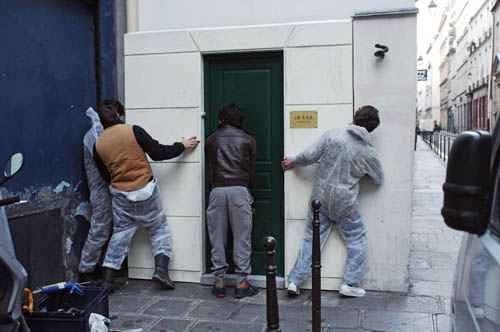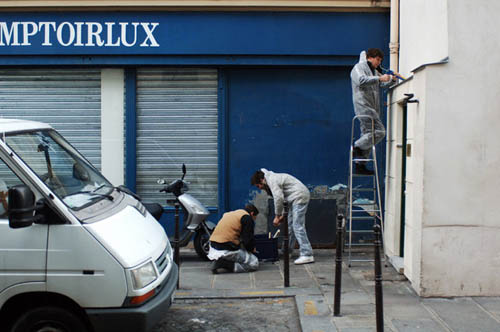Berthier's Door
 [Image: From Les spécialistes by Julien Berthier and Simon Boudvin].
[Image: From Les spécialistes by Julien Berthier and Simon Boudvin].Back in 2006, early on a Saturday morning, artists Julien Berthier and Simon Boudvin installed a new door in the city of Paris—but it was a fake door, leading nowhere, on an otherwise empty wall in the 3rd arrondissement.
 [Image: From Les spécialistes by Julien Berthier and Simon Boudvin].
[Image: From Les spécialistes by Julien Berthier and Simon Boudvin].The project was called Les spécialistes. "The façade, using the local architectural codes, occupies 10 cm of public space," Berthier explains, "and was mounted and glued on in thirty minutes."



 [Images: From Les spécialistes].
[Images: From Les spécialistes].Unbelievably, Berthier adds, "Almost 4 years later, the address still exists. Regularly graffitied it is even cleaned by the city service.”
 [Image: Les spécialistes seen in 2009; its co-creator, Julien Berthier, has a flair for secret doors].
[Image: Les spécialistes seen in 2009; its co-creator, Julien Berthier, has a flair for secret doors].In a way, I'm reminded of an article published last month in New York magazine called "There’s a Brownstone in Brooklyn With a Secret Passage to the Subway." There, the magazine wrote that "among the lovely three-story brownstones in Brooklyn is one extra-special home, one that really isn't a home at all. It's merely a façade that serves to disguise a passage into the dark subway tunnel" below. An emergency evacuation-and-access system for the subway, the doorway and its Potemkin house remain unmarked and undisclosed; it is the NYPD as Julien Berthier. (Which, in turn, reminds me of the Rentable Basement Maze).
But, of course, these sorts of "fake" spaces are not uncommon at all. There are also "dummy houses" in London—specifically at 23-24 Leinster Gardens—that were constructed from the very beginning as nothing but façades. They don't even have interiors; they are simply vents for the Underground, disguised as faux-Georgian flats. Check out some cool photos of them over at Urban 75.
This further brings to mind, however, a scene from Umberto Eco's underappreciated novel Foucault's Pendulum, where the narrator, being regaled with tales of subterranean Paris, is told that, "People walk by and they don't know the truth... That the house is a fake. It's a façade, an enclosure with no room, no interior. It is really a chimney, a ventilation flue that serves to release the vapors of the regional Métro. And once you know this you feel you are standing at the mouth of the underworld..."
Fake buildings and fake doors with secret interiors—or interiors that don't even exist. Purloined interiority.
Might I suggest, then, in light of these examples, that if someone, someday, were to approach Berthier's Door—after all, it deserves a name, capitalized and cartographically handed down friend-to-friend in a countergeography of the city—and finds themselves able to open it, to step through into a labyrinth of staircases and rooms stacked one on top the other leading down dozens of meters, and they are then able to explain later, after emerging somewhere perhaps near Dijon, what marvels of literally suburban cross-connection exist back there in a knitted fabric of minor spaces no one else has ever seen, that art, architecture, and mythology will finally have experienced their rightful co-identification.
 [Image: Berthier's Door—near 1 Rue Chapon—visible on Google Street View].
[Image: Berthier's Door—near 1 Rue Chapon—visible on Google Street View].Or, perhaps, if someone installs a door of their own—atop a hill in the 19th arrondissement, or down on a side-street near the Musée des arts et métiers, site of the now-irreparably damaged Foucault's Pendulum, or over in Moscow somewhere with its rumored secret subway—a maze of connective spaces will open up between them—indeed, wherever you install a door, in any city, if you simply wait long enough, the invisible network of tunnels burrowing away in the background of urban awareness will eventually come to find it.





Comments are moderated.
If it's not spam, it will appear here shortly!
What is the ugly concrete footer that has been added in later photos?
here's a recent expedition into the paris underground, through a hole next to an abandoned railway in the 15th arr!
http://untappedparis.wordpress.com/2010/05/17/the-paris-underground-an-introduction/
@DonsSword I'd assume it's there to prevent puddles from forming in that corner.
In Berlin – which is full of never-finished tunnels and stories about their mysteries – some people are taking care of a number of fascinating underground spaces: http://berliner-unterwelten.de/home.1.1.html
I'd be afraid that Berthier's Door opened up into the House of Leaves
I immediately assumed the ugly concrete footer was snow.
This reminds me of Neil Gaiman's Neverwhere, a dark trip down the rabbit hole into an underground London.
There is magic in the expectation and disappointment of fake, deceiving and ultimately useless objects. Reminds me of this: http://www.youtube.com/watch?v=Z86V_ICUCD4
This fella might have closed the "useless loop" : http://crazymotion.net/double-useless-object-/wD4m0flnlbXMjAy.html
This fake door story is lovely.
It also got me thinking about how the generative value of fiction and the material reality of the fake rub together. The fake is a fiction, but unlike fictions it has to actually materially be somewhere in order for it to do the pretending work that a fake, by definition, does. Or at least, it has to call up the material actuality of something known or recognisable. In that sense, all fakes could be seen as doorways to a double life: something that doesn't actually exist right here (a fiction) but does somewhere else (where ever and how ever the 'authentic' thing does).
Through the actuality of it's pretense it inhabits a spatio-temporal disjunction nowhere : a pre-tense – before entering into a particular time (past, present or future). But the 'pre-' implies that there is an afterwards where it will find a time, or achieve a tense.
This example of a fake door is perhaps so lovely because the fake is always a doorway to a time and place that is actually elsewhere – or isn't here yet.
Fact & Fiction
http://www.rockpapershotgun.com/2009/04/21/locked-door/
Yes! I have had potential- occult- and interstitial-interiority on the brain as part of a story I'm doing on the Homo Floresiensis community in Saint Paul, MN. I'm put in mind of the Ann Arbor fairy doors.
As regards occult and interstitial interiority: When I lived in Taiwan twenty years ago, teenagers would ride their scooters out to freestanding doorways in the middle of farm fields and descend into the defense tunnels to smoke, drink and get laid.
Reading this, I couldn't help but think of the video game Portal. From what I've gathered having only made it to level 12, the challenge is to solve a series of spacial puzzles using a hand-held portal device: how to get to the other side of the room without falling into a pit of toxic fumes and flames, for example. One has to think about not only the mechanism of making a doorway through which one can then emerge from, but also the physics behind one's movement-- i.e., the momentum required to make the trip (or the fall). It's a compelling way to think about space, and certainly food for architects. I'd like to see architects taking these sorts of impossibilities more seriously. Can these elusive pathways be constructed? Are they already there?
Meanwhile, in Second Life: Anywhere Doors.
Please check out the work of this excellent Dutch public artist:
http://www.harmendehoop.com/
Ronald van Tienhoven
This remind me the work of a parisian clandestine group : The "UNTERGUNTHER UX" lead by Lazar Kunstman.
They're using unknowed place of Paris for cultural event.
http://web.mac.com/peint/UGWK/Untergunther_Press.html
Here's the address of the door!
http://untappedparis.wordpress.com/2010/05/27/berthiers-door-found/
I agree with Lydia that these elusive pathways should be taken seriously, but then again, perhaps they already are, if perhaps not always consciously - the Trompe l'Oeil believing itself a decorative solution to a bit of dead wall, perhaps, Michelangelo's blind windows, Lutyens' columness capitals, Soane's tricks with voids... My contribution to the stock of literary equivalents would be mention of Caillois' lovely Little Guide of the XVth Arrondissement Intended for Fantoms, where a narrator ruminating on such things eventually becomes convinced of the existence of the ethereal life forms they imply, and that he belongs among them. An illustrated intro's to be found here:
http://bloc-notes.thbz.org/archives/2008/05/les_fantames_du_1.html
Berthier's door may lead to "La Ligne B", a book of drawings done in the Parisian RER between 2006 and 2009. See http://jacquelinechesta.wordpress.com/
Remarkable.
I wonder if speaking about it on the Internet may not threaten the existence of such an administrative anomaly.
A few years ago, I discovered a false ex-voto in Église Saint-Sulpice, which someone had apparently put there as a birthday present for artist Sophie Calle. I blogged about it (http://bloc-notes.thbz.org/archives/2004/08/sophie_calle_a.html). When a friend tried to see it later after reading my blog entry, she couldn't find it because it had been removed. So I imagine that another reader may spoken to the keeper of the church? Although it may be more likely that they found it themselves.
By the way, the concrete footer is common in Paris. Its function is to prevent dogs, men and other animals to pee there.
I second @thierry. The last time we talked about this in public the matrix coders rewrote part of the API and I couldn't get out of my house!
Incredibly poetic!
Argentinian writer Ernesto Sabato had similar thoughts about this kind of darkness in urban existence in "Informe sobre ciegos ("inform about the blind") an awesome book inside another book "On Heroes and Tombs"...
As french people say, "les grands esprits se rencontrent" !
http://www.pop-up-urbain.com/adresse-inconnue-a-cette-adresse/ (05.12.2010) :-)
You can find more analysis in this link : http://www.mainsdoeuvres.org/article458.html
"L’espace commun de la polis devient alors un lieu propice à l’étrange et l’étranger pour peu que l’on remarque les changements qui s’y opèrent. La matérialisation d’une adresse réelle pour abriter une profession apparemment fictive crée un non-lieu qui ne relève ni de l’utopique, ni de la pratique. La « prise de pouvoir » des artistes face et via l’architecture et ses moyens donne naissance à des univers dont les références nous sont communes mais dont l’usage nous est étranger, si ce n’est interdit. Une fin de non-recevoir le principe de réalité ?"
Post a Comment